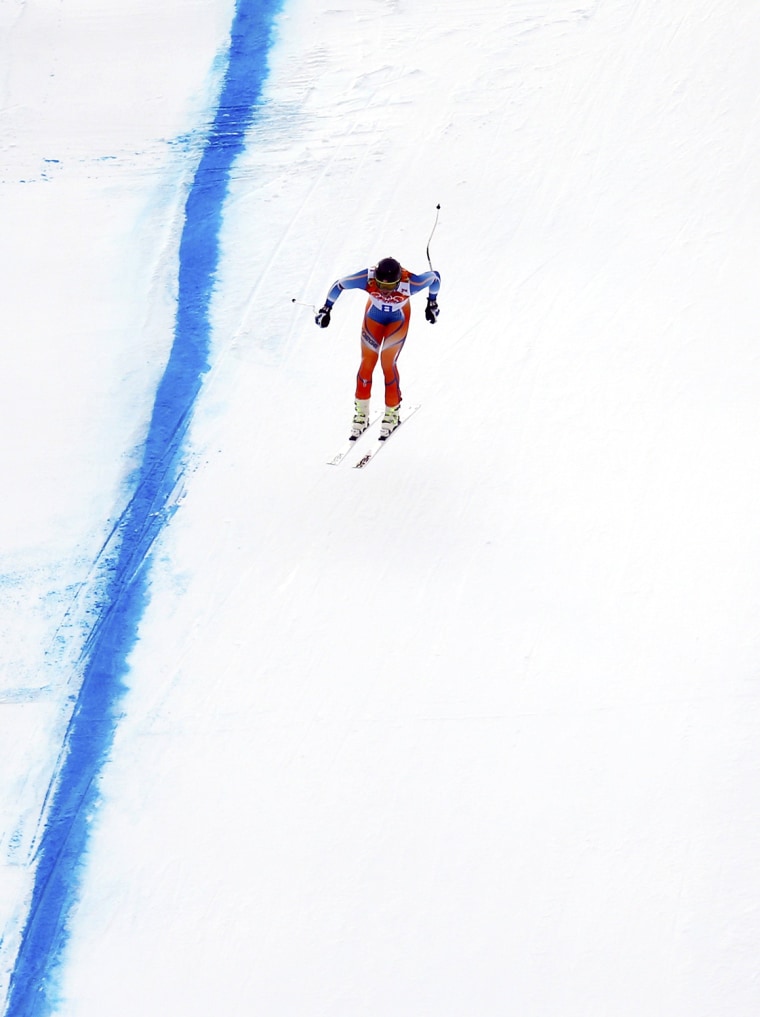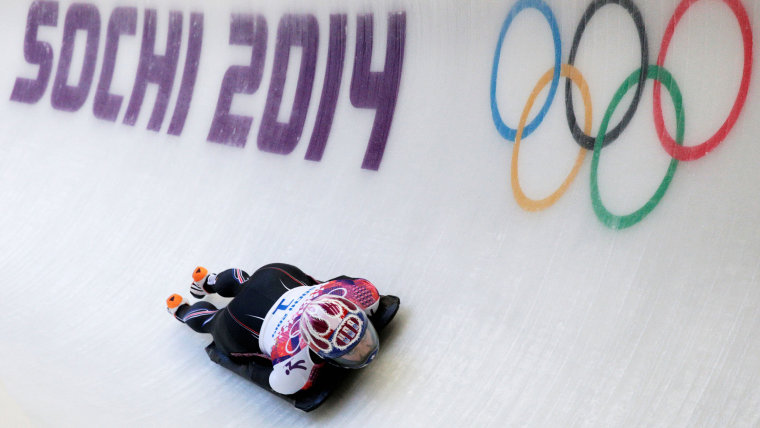Watching the Sochi Olympics and wondering about those blue lines, why anyone would willingly sign up for skeleton, or what all the anchors do during their downtime? We've got answers to the burning questions you asked us on Facebook! Check out more Olympic queries solved here.

Q: What’s up with the blue lines on the slopes?
-Barbara Nichols, via Facebook
Those lines, which are made from blue dye put on the course by track workers, serve as visual cues for the competitors. It can be hard to judge the edge of the course when it’s just a large white expanse.
The lines help athletes plan their runs down the mountain, particularly on cloudy days where the whiteness of the sky can blend with the ground. They help the racers gauge the distance across between the gates. The competitors are not required to stay between the blue lines during a run, just between the gates.
Back in the 1980s, before the blue lines became the norm, eight-inch pine boughs were shoved into the ground by track workers every few feet down the course to serve as visual cues.
The same goes for the blue line in snowboarding: It helps give the rider perspective on where the edges of the course are and helps athletes prepare for landing while in the air; they can use the line to gauge when they are about to hit the ground.

“Those are just basically so you can see where you’re going, for depth perception,’’ snowboarder Greg Bretz told TODAY.com. “They don’t mean anything other than that."
Q: How/why does one choose to become a skeleton athlete? Are they wearing padding and how are they controlling the sled?
-Jennifer Zimmerman Krause, via Facebook
Skeleton riders wear sleek, skintight suits with barely any padding in order to cut down on aerodynamic drag for speed. Even though they hurtle headfirst down an icy track on a sled barely bigger than a cafeteria tray at speeds that reach 90 miles per hour, their only real protection is their helmet and some elbow padding in the suit. While experiencing gravitational forces that reach up to 5Gs, they steer with their shoulders, knees and toes. Racers need serious core strength because their bodies are their only steering mechanism.
The upside of flying headfirst down the track? Awesome helmets. Most racers have custom helmets with designs on the crown of their head that can be seen as they zoom down the course. Canada’s John Fairbairn has the outline of a brain on his helmet, Katie Uhlaender of the U.S. has the fierce visage of a bald eagle, and Canada’s Mellisa Hollingsworth has a horse head skeleton design.
Many get into the sport because they grow up in a place that has access to a course, or they are convinced by existing athletes in the sport to give it a try. American Noelle Pikus-Pace competed in skeleton in high school while attending Mountain View High School in Utah, near the Olympic skeleton course in Park City. "My coach happened to work at the Park City bobsled track, so when I was a junior in high school he said, 'we're recruiting track and field athletes to try it,'" she told TODAY.com. "Luckily, I lived close to the bobsled track, so it made sense."
Uhlaender met U.S. bobsledder Sara Sprung in a weight room in Silverthorne, Colo., and Sprung convinced her to give skeleton a try. Sometimes simply watching someone else do it is enough to get an athlete hooked. U.S. skeleton racers Matt Antoine and Kyle Tress first gave the sport a try after watching it at the 2002 Winter Olympics in Salt Lake City. John Daly, another U.S. skeleton racer, tried luge at first after seeing the son of one of his coaches compete and then switched to skeleton while training for luge.
Q: What does the TODAY team do when they're not on the air?
-Lisa Jackson, via Facebook
When they're not bringing you the news from Sochi, the TODAY anchors aren't exactly lounging around in Russian baths. They say there isn't much downtime during the Olympics, though they have been able to squeeze in some workouts.
"I go to the gym, and we've got that great promenade out back, so I knock out a few miles there," Al Roker told TODAY.com. "I’m listening to an audio book, Michael Connelly’s 'The Gods of Guilt.' I went to U.S. v. Russia hockey, that was pretty great. I’d never seen a shootout before. I also went to team figure skating."
"I don't have a ton of free time," said Willie Geist, "but there's a promenade outside our hotel, along the Black Sea. I walked out there alone to take a run and in the span of three minutes I saw Jenna Bush Hager and Savannah Guthrie — it's like everyone from the TODAY show is out because it's 70 degrees here. So I'd say everyone is either working out or eating."
There are some perks to being on the other side of the globe: "Since we're not waking up at 3 a.m., the morning is a good time," Willie added. "It's kind of like a weekend day, when you wake up, stretch out, read something, check your email, go for a run before work. It's like our whole days are flipped. I go to bed as late as I can — last night I went to bed at 1 a.m. A week from now, I'll be going to bed like a child again, so I might as well stay up."
"We all went out to a delicious dinner at an Armenian restaurant Friday night," said Jenna Bush Hager, of how she's been spending her free time. "There have been a lot of runs and walks along the Black Sea. We don't have much downtime."
(Also, they're checking out matches!)